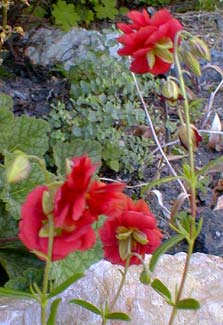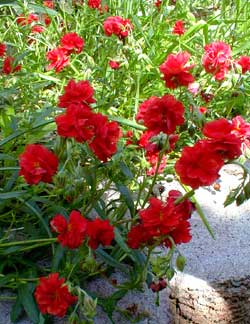
'Ball of Fire' or 'Fireball'
aka 'Mrs. C. W. Earle'
Double Red Sunrose
"Half the interest of a garden
is in the constant exercise of
the imagination. I believe that
people entirely devoid of
imagination never can be
really good gardeners. "
-Mrs. C. W. Earle, 1897
This 1981 introduction, 'Boule de feu,' is shown consecutively in the first June (2003) & May (2004) photos. This cultivar's flowers are much smaller than single sunroses & rock roses, yet they are stand-outs because they are very bright scarlet "doubles" that form fiery little balls. It's a recipient of the Royal Horticultural Society's Award of Garden Merit for its extreme beauty & ease of growing.
 Though only as wide as a dime, they are no less showy than non-double varieties with blossoms wider than a quarter. As with many sorts of double-blooms which have extra petals instead of sex organs, it waits & waits to be pollinated, which is impossible for it; & since it cannot go to seed it is still blooming in November in our Zone 8 sun-garden, by which time all the fertile Helianthemum nummularium cultivars have ceased blooming for months.
Though only as wide as a dime, they are no less showy than non-double varieties with blossoms wider than a quarter. As with many sorts of double-blooms which have extra petals instead of sex organs, it waits & waits to be pollinated, which is impossible for it; & since it cannot go to seed it is still blooming in November in our Zone 8 sun-garden, by which time all the fertile Helianthemum nummularium cultivars have ceased blooming for months.It won't last until November in cooler zones, but to September at least. Ours is not slowed down by a "mere" week of frosty days. The late rebloom might be further encouraged by a moderate amount of sheering if it has that brief interuption in flowering at high summer.
The cultivar name is often rendered into English as either 'Ball of Fire' or 'Fireball.' It is the same as what in England is better known as 'Mrs. Earle' or 'Mrs. C. W. Earle.' Mrs. Earle (1838-1925) was a Victorian garden writer of some note, whose Potpourri from a Surrey Garden (1897) & two follow-up volumes are regarded as gardening classics.
Most sunrose blooms last for a single day only, but the shrublets produce such a great many flowers there are new ones every day, plus a veritable carpet of colorful petals that fell to the ground from the day before. The double sunrose by contrast keeps each bloom for a couple of days & fallen petals accumulate much more slowly.
The semi-evergreen foliage is much more slender than the other sunroses, not as compact. The loosely leafed stems behave somewhat like creeping vines instead of a subshrub, & it rarely pokes upward any higher than about six inches.
It is slower in its spread than our "regular" H. nummularium cultivars, & also slower to recover from winter injury. When it starts blooming anew in May, whatever wear the leaves took through winter may not quite as yet be repaired. But then of course it makes up for any slight tardiness by blooming pretty nearly the rest of the year.
As with regular hybrid sunroses, it is extremely drought tolerant, but not very tolerant of dampness, requiring perfect drainage. Ours is on the stacked-brick ledge of a sun-garden where it should always have plenty of drainage even through autumn & winter rains. Our soils are naturally kind of humusy, rich, & acidic, & 'Fireball' does fine as do our other sunroses, but their ideal would be soils to the chalkier or alkaline side of the pH scale.
Though it hasn't happened with ours, 'Fireball' or 'Mrs. Earle' is known to produce occasional branches that are variegated. If a new plant is started from cuttings of the variegated portion, the resultant cultivar is known as 'Gaiety.'
Helianthemum nummularium 'Annabel.'